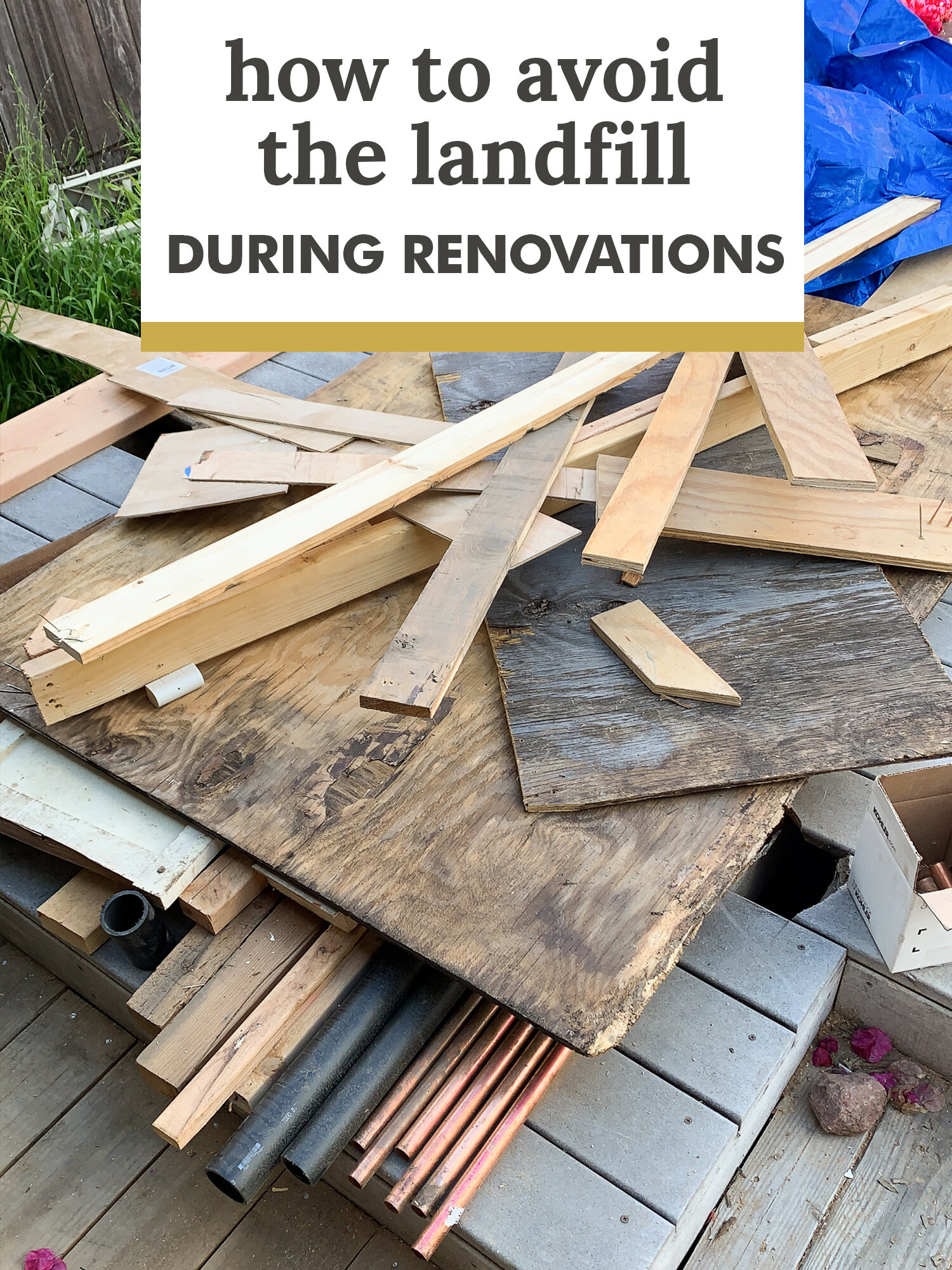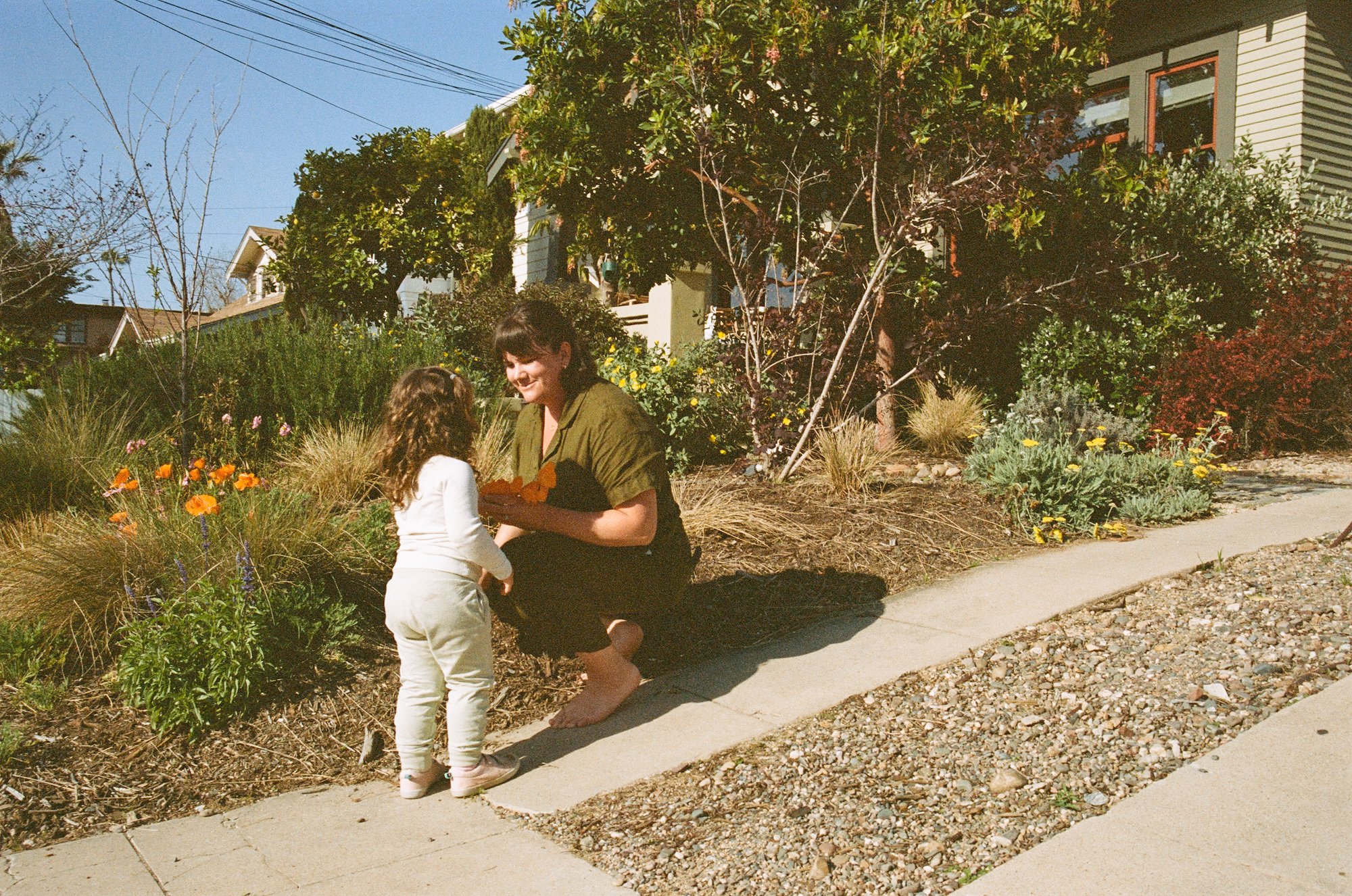Home Renovations Don't Have To Be Wasteful - Here’s How To Avoid The Landfill
/When we think of renovations and demolition, we often imagine a dumpster full of materials and debris from a gutted room. HGTV has taught us that #demoday is the day to take a sledgehammer to the outdated cabinets and a reciprocating saw to an old banister. But it doesn’t have to be like that! We can restore, renovate, and even demolish rooms without sending every little thing to the landfill.
First, I’ll briefly get on my soapbox to share why this is important:
The United States generated 569 million tons of construction and demolition debris in 2017, which is more than twice the amount of generated municipal solid waste.
Building-related materials are the largest contributor of waste in our landfills, but they don’t need to be.
I get it. When we decide to replace something with another thing, it feels like the original item is useless trash. It feels like that’s just where it belongs. But if we shift our mindset about how we view things we no longer want and identify resources for upcycling, we can avoid all of that rubbish sitting in those piles for centuries.
I also get that it’s overwhelming. We’re used to throwing away small things and then taking out a small bag of trash at the end of the week. But looking at a five-foot-tall pile of lumber and scrap materials is overwhelming. It’s hard to know what to do with that stuff that you don’t commonly use on a daily basis.
However, we have a responsibility to do better than chucking things in the dumpster. It takes a bit of work and foresight, but someone has to do it. If you have the resources to do a big renovation, you have the resources and responsibility to recycle the materials you get rid of. Yes, it will take time to offload things to proper homes. Yes, you may need to keep a pile of materials while you wait for someone to pick it up. Yes, you may need to spend time researching local recycling resources. But it’s important to recognize that once we put things in the trash, we’ve signed away their opportunity to be repurposed. Anna (@thetrashwalker) isn’t going to go through every bag of your trash and take the time to find a new use for it, as rad as it is that she does it in her community.
As an aside, I also want to point out that while we have a responsibility and privilege to find new uses for our trash, it’s not solely the consumer’s responsibility to manage our waste. For starters, non-residential construction accounted for 61 percent of the building waste sent to the landfill. Homeowners aren’t behind all 569 million tons of that trash. In fact, just 100 corporations are responsible for 71% of global greenhouse gas emissions! The crisis is presented as a moral failing on the part of individuals, but it isn’t on us. Yes, we should do what we can in our homes, but the most effective change is for us to pressure corporations to do better and vote for governmental change. Zero waste is more than avoiding a plastic bag.
I also want to mention that while I don’t like sending unnecessary waste to the landfill, it doesn’t mean we can’t renovate our homes. I think that mindful renovation can coexist with restoration and zero waste. The two things aren’t mutually exclusive. I aim to renovate in a way that doesn’t need to be renovated for decades or even a century.
This concludes my preachy rant that I really could have gone on and on about. If you want more information about breaking down our waste systems, read the writings of my friend Polly and look at what Anna is finding in dumpsters in NYC for a sobering look at our trash.
Let’s get into the fun part. Repurposing our trash!
Get Creative and Upcycle!
The biggest recommendation is to find new uses for things that you don’t have a use for. Upcycle things for yourself, or give them to a neighbor! Giving things away is my biggest tip - hey, one (wo)man’s trash is another’s treasure. Right?
Here are some examples of repurposing construction materials.
Do you remember when during demolition, I had the crew save all of the wooden lath strips found in the walls? Well, I gave most of it away to a lady that’s building a chicken coop out of it! I saved some for a TBD project myself. Daniel even turned his spare lath into an accent on his cabinet by sanding it down and cladding it to an existing cabinet in his den. I’m thinking I can use it for a trellis for plants - stay tuned for that.
When we drywalled the kitchen, I saved all the scrap pieces of drywall (or sheetrock) that were bigger than 4”x4.” I reused the big pieces to build the hood for my range which saved me $$ and then I saved a few pieces for patches down the road. The rest of it was given away to neighbors for patch jobs. One lady that picked up the spare pieces is a social worker who has a client with PTSD that has been punching holes in her walls. The social worker picked up the leftover drywall to give to her client so she can teach her how to repair her walls, save money, and recognize the work it takes to make the repairs. I also came across this art project tutorial using scrap sheetrock to make reliefs.
Lumber accumulates pretty quickly on a job site. Offcuts from new wood or old lumber can easily get chucked into the dumpster. But, I asked the crew to set aside any pieces of reusable wood. Then, they’d pull from it whenever they needed a spare 2x4 or scrap piece. We managed to repurpose most all of the scrap lumber. But when I got tired of the big pile, I offered it up to neighbors for free and they took it all away. A neighbor collected some to help her son build a boat, another neighbor used them for crafts, one made a giant scrabble board out of it! Kim and Scott made a giant jenga game out of their scraps!
Salvaged millwork and flooring is definitely something that doesn’t belong in the trash! Old-growth wood is superior to what we can buy today so it’s worth saving and repurposing! I kept all of the trim and casings from doors which I’ll be putting back in the house to re-case the new doorways (stay tuned for that) and I kept all of the old hardwoods too. I saved a few pieces of flooring but I had a lot so I did give some away to neighbors that had patching needs in their old houses.
Delivery boxes can become forts for kids, drop cloths for painting projects, new shipping boxes, garden mulch, cat trees, and a hundred other things! I always save some boxes for myself to ship things, or to use as scrap templates for laying out cabinets, or for a dropcloth to paint over. But these big ones make for such good creative repurposing. A neighbor took the boxes above for her kids to play with and another neighbor took it for mulch in her garden. Win win!
The old door that went to the backyard wasn’t original to the house and I had no need for it, so I gave it away to someone building a small shed in her backyard. I also gave away my old windows to someone that’s pulling out vinyl windows and replacing them with authentic wood windows. I bought salvaged windows myself!
The old kitchen sink was taken apart and I sold the garbage disposal on Craigslist, then gave the sink to my sister to make a planter bed out of it for her garden.
We had some spare copper pipes that I gave away to a neighbor doing plumbing projects. But I saved a few of the house’s original copper pipes with a pretty patina to repurpose for my own projects. Copper pipes make for great rods to hang curtains, cups, cookware, etc. from. But they also work great for making crafts because you can buy connector joints to build things in 3D. My friend Alison made a plant stand!
I’ve shared some big renovation scraps, but I got resourceful with even the little things! The handles that came on the packaging of my french doors were just used in transportation, so when I removed them I gave them to a neighbor who attached them to her camping boxes in her truck. It’s really the little things, folks!! So many random bits and bobs make for creative upcycling!
I even put sawdust to use! When we sanded the oak floors, the tiny wood particles were collected in dust bags that I dumped straight in my compost! Be sure you don’t compost wood with any synthetic paints/coatings/etc. on it, but by all means put the sawdust in the compost!
Are you getting the gist? Save the stuff, find a neighbor that needs it, and give it away! Curious where to give things away? I highly recommend the Buy Nothing Project and the Free Section of Craigslist. I even put some things on the street with a “free” sign. You could sell things on eBay, OfferUp, Facebook Marketplace or other local second-hand sellers. I put my efforts toward placing things where they’d find a home for free rather than trying to sell stuff and negotiate with buyers.
Not sure how to come up with crafty upcycle ideas? Google the name of the material, and then the word “game” or “project” or “craft” to get results. Dowel game, copper pipe project, and cardboard craft yields oodles of results. Talk about great quarantine activities for kids!
Consider our homes to be organ donors. The room/cabinets/materials may have come to the end of its life in your home, but it can prolong the life of many other homes, or inspire creativity for others.
Specialty Recycling
Some things are just not special enough to upcycle or reuse. The cracked cast iron vent and the corroded galvanized pipes in particular aren’t too useful for repurposing. All of those scraps I took to the metal recycling drop off. I even got cash - I think in total I made $25. I’m rich!
Also, it was very cool there. It was inspiring to see all of the metal junk getting sorted and imagining it taking shape in new ways. Plus, they played Mariah Carey on the speakers the last time I was there. You should find metal junk just so you have an excuse to go to your local metal recycling facility.
Safe Disposal Sites
In addition to familiarizing yourself with recycling facilities, it’s also a good idea to find local disposal sites for toxic materials.
Pulling things from houses can reveal dangerous materials like lead and asbestos. These are things to be very cautious of and you should exercise caution when disposing of them. You can’t put these things straight in your trash bins, so check the regulations in your area. Simply Google your region and the item to dispose of (ex: “San Diego Lead Abatement”) to find professionals in your area to safely remove the materials, or learn where small amounts of these materials can be safely dropped off by homeowners.
Salvage Shops
I gave most everything away to neighbors via my Buy Nothing Group because I find it most effective to list a specific item and get it straight to the person in need. If someone at the end of your block needs a microwave, get it to them directly rather than dropping it off at a donation center and hoping your neighbor finds it. Makes sense, right?
However, I loooove salvage shops for when I’m hunting for things! A common one is Habitat for Humanity ReStore, but there are lots of small businesses that make a living off of gutting properties and selling the items inside - mostly high-end properties. A local one is Re-Find Homes. Then there’s Builders Trading who sells surplus building materials in North County San Diego and Architectural Salvage who sells old house parts in Little Italy, San Diego.
If you have nice kitchen cabinets PLEASE don’t take a sledgehammer to them! You can remove them carefully and donate them to an organization that will re-home the items to someone looking for kitchen cabinets, or simply someone that wants to update their garage storage. Even if you think they’re outdated or funky, please give someone the opportunity to fix them up!
I hope my list of items I managed to give away inspires you to recognize that (most) everything can be repurposed.
Did I Throw Anything Away?
Yes! I did. Don’t go thinking you can renovate without making some trash. We sent old insulation, crumbled plaster, and other bits and bobs to the landfill. We did a couple of trips to the dump in a pickup truck and avoided needing an entire dumpster.
Unfortunately, there are some things that are hard to upcycle depending on your jurisdiction. When we replaced our roof, I did lots of research to find how I can recycle the asphalt to turn it into roads. Unfortunately, my area doesn’t allow that, but maybe your does! Read about it here.
I had to sift through garbage bins, take time to measure items to list online, spend hours meeting up with neighbors to pick things up, and did have to live with piles of materials until the new owner could pick them up. But it felt really good to see things get a second life, and I think it was my responsibility to do so given my privilege of renovating.
This post covered solutions for things during the demolition process, but here are a few more suggestions for other home projects:
Wash your paintbrushes instead of throwing them away
Save plastic bags and packing materials to use as mini drop cloths or make a trash pumpkin!
Buy antiques or second-hand furnishings
Shop at your local Habitat For Humanity Re-Sale shop where they even sell paint. See my joy of salvaging old windows here.
Research alternative building methods and consider going beyond the expected
Use what you have! The power of paint and new hardware is incredible
Clean and maintain your things so they last longer and don’t need to be replaced in a few years
Buy quality pieces now rather than buying something flimsy and cheap with the idea that you’ll toss it in a year
When landscaping, recycle greens and give away plants you don’t like
Get resourceful about where you donate things
Please share in the comments other ways you’ve reduced waste during home renovation projects!
































